

The Ninja Platform. You Are the Network. Drive a webpage in real-time using Arduino, SensorMonkey and Processing.js -Arduino for Projects. Remote visualization of real-time sensor data.

This tutorial describes in detail how to use the free SensorMonkey service to push real-time sensor data from an Arduino to a webpage for visualization using Processing.js. No server-side coding or Ethernet shield is required. A standard, run of the mill Arduino will work perfectly. You’ll also need a sensor to sample some values. I use an accelerometer, but anything will work (a potentiometer, a gyroscope, a tilt sensor, a temperature sensor, a light sensor etc.).
After configuring the Arduino to sample sensor values, I use SensorMonkey to publish the data live over the Internet in real-time (Disclosure: I co-founded the company developing SensorMonkey). UPDATE 26-06-2012: Non-Windows Users As an alternative to Bloom for non-Windows users, I have uploaded a Processing sketch, namedSensorMonkeySerialNet, to our GitHub account. Step 1: Gathering Materials Hardware: SensorMonkey - Support: Bloom. Please read the following sections to find out more about Bloom and to download the software: What is Bloom?
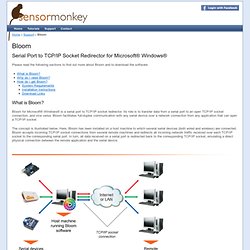
Bloom for Microsoft® Windows® is a serial port to TCP/IP socket redirector. Its role is to transfer data from a serial port to an open TCP/IP socket connection, and vice versa. Bloom facilitates full-duplex communication with any serial device over a network connection from any application that can open a TCP/IP socket. The concept is illustrated below. Each instance of Bloom supports up to 4 simultaneous connections (see below), where each connection is a one-to-one mapping (i.e. a single serial port mapped to a single TCP/IP socket). In addition, Bloom also includes a built-in Flash® socket policy file server to enable browser-based applications running in the Adobe® Flash® Player to open binary TCP/IP socket connections to the host machine running Bloom, facilitating direct communication with a serial device from within a Flash® application.
Why do I need Bloom? Maybe you don't! SensorMonkey. EVRYTHNG. EVRYTHNG. Cumulocity GmbH. Xively – Public Cloud for the Internet of Things. Internet of the Things for Business and Internet of Objects for Consumers? With so many optimistic predictions about IoT is not surprising that companies large, medium and small are rowdy and excited to see which part of this big cake can take.
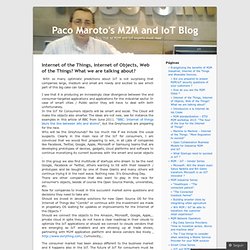
I see that it is producing an increasingly clear divergence between the end consumer-targeted applications and applications for the industrial sector. In case of smart cities / Public sector they will have to deal with both unfortunately. In the IoT for Consumers objects will be smart and social. The Cloud will make the objects also smarter. The ideas are not new, see for instance the examples in this article of BBC from June 2011. The consumer market had been always different to the business market and it happens also in the IoT. m2m.eclipse.org — M2M development made simple.
M2M Webinars. Machine-to-Machine (M2M), sometimes called Internet of Things, refers to technologies that allow wired and wireless machines/devices to communicate with each other.
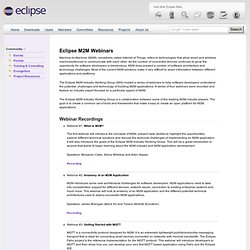
As the number of connected devices continues to grow the opportunity for software developers is tremendous. M2M does present a number of software architecture and technology challenges. Most of the current M2M solutions make it very difficult to share information between different applications and platforms. The Eclipse M2M Industry Working Group (IWG) hosted a series of webinars to help software developers understand the potential, challenges and technology of building M2M applications.
A series of four webinars were recorded and feature an industry expert focused on a particular aspect of M2M. The Eclipse M2M Industry Working Group is a collaboration between some of the leading M2M industry players. Webinar Recordings. Paho - Open Source messaging for M2M. MQTT. MyMQTT - Aplicativos para Android no Google Play. ★★Run over 60 servers with over 70 protocols!
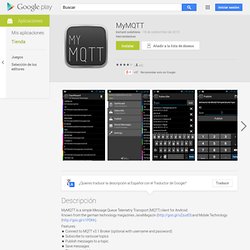
★★ MQ Telemetry Transport (MQTT) V3.1 Protocol Specification. MQ Telemetry Transport (MQTT) V3.1 Protocol Specification. Building Smarter Planet Solutions with MQTT and IBM WebSphere MQ Telemetry. MQTT V3.1 Protocol Specification. This specification is split into three main sections: the message format that is common to all packet types,the specific details of each packet type,how the packets flow between client and server. Information on how topic wildcards are used is provided in the appendix. 1.1. Changes The following are the changes between MQTT V3 and MQTT V3.1: User name and password can now be sent with a CONNECT packet New return codes on CONNACK packets, for security problems Clarification that clients are not informed of un-authorized PUBLISH or SUBSCRIBE commands, and that the normal MQTT flow should complete even though the command has not been performed.
The protocol version number passed with CONNECT packets, is unchanged for this revision, and remains as the "3". 2lemetry Demo. MQ Telemetry Transport. MQ Telemetry Transport (MQTT) [1] is a publish-subscribe based "light weight" messaging protocol for use on top of the TCP/IP protocol.
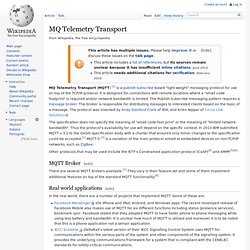
It is designed for connections with remote locations where a "small code footprint" is required and/or network bandwidth is limited. The Publish-Subscribe messaging pattern requires a message broker. The broker is responsible for distributing messages to interested clients based on the topic of a message. The protocol was invented by Andy Stanford-Clark of IBM, and Arlen Nipper of Cirrus Link Solutions. The specification does not specify the meaning of "small code foot print" or the meaning of "limited network bandwidth". Other protocols that may be used include the IETF's Constrained application protocol (CoAP)[4] and XMPP.[5][6] MQTT Broker[edit] There are several MQTT brokers available.[7] They vary in their feature set and some of them implement additional features on top of the standard MQTT functionality.[8] Real world applications[edit]
The Internet of Things gets a protocol. News By Joab Jackson April 26, 2013 03:37 PM ET IDG News Service - Setting the foundation for what may be a multitrillion-dollar marketplace, OASIS (the Organization for the Advancement of Structured Information Standards) has declared MQTT (the Message Queuing Telemetry Transport) as its messaging protocol of choice for the emerging Internet of Things.
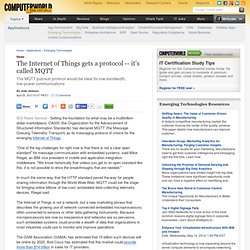
"One of the big challenges for right now is that there is not a clear open standard" for message communication with embedded systems, said Mike Riegel, an IBM vice president of mobile and application integration middleware. "We know historically that unless you get to an open standard like this, it is not possible to drive the breakthroughs that are needed. "
An Open Source MQTT v3.1 Broker. XMPP. Official logo Extensible Messaging and Presence Protocol (XMPP) is a communications protocol for message-oriented middleware based on XML (Extensible Markup Language).[1] The protocol was originally named Jabber,[2] and was developed by the Jabber open-source community in 1999 for near real-time, instant messaging (IM), presence information, and contact list maintenance.
Designed to be extensible, the protocol has also been used for publish-subscribe systems, signalling for VoIP, video, file transfer, gaming, Internet of Things applications such as the smart grid, and social networking services. The Internet Engineering Task Force (IETF) formed an XMPP working group in 2002 to formalize the core protocols as an IETF instant messaging and presence technology. The XMPP Working group produced four specifications (RFC 3920, RFC 3921, RFC 3922, RFC 3923), which were approved as Proposed Standards in 2004.